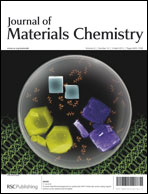The influence of composition on the physical properties of PLA-PEG-PLA-co-Boltorn based polyester hydrogels and their biological performance†
Abstract
Hydrogels based on segmented PLAaPEGbPLAa triblock copolymers have been extensively researched for biomedical applications, largely for drug delivery and tissue engineering applications, due in particular to the ability to tune their rate of degradation. By copolymerizing acrylated PLAaPEGbPLAa with acrylated Boltorn-PEG (BH20PEGA) macromonomer, the resulting hydrogels show enhanced swelling, and thus enhanced in vitro degradation profiles in PBS (pH 7.4) at 37 °C, compared to the hydrogels based on the triblock copolymers alone. The swelling ratios of the gels in water and in phosphate buffered saline solution, PBS, all decrease with increasing length of the PLA segment in the PLAaPEGbPLAa macromonomer and increase with increasing molecular weight of the PEG segment. The rates of mass loss of the hydrogels in PBS (pH 7.4) at 37 °C were higher for hydrogels with longer PLA segment length and higher PEG MW. Cytocompatibility studies confirm that the hydrogels are biocompatible and support the proliferation and attachment of periodontal fibroblasts.


 Please wait while we load your content...
Please wait while we load your content...